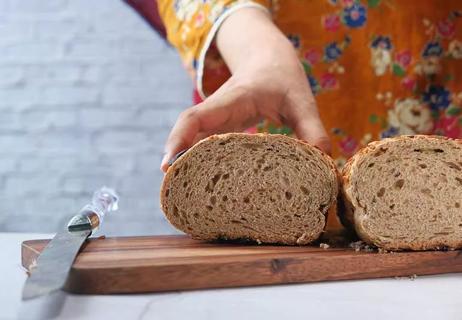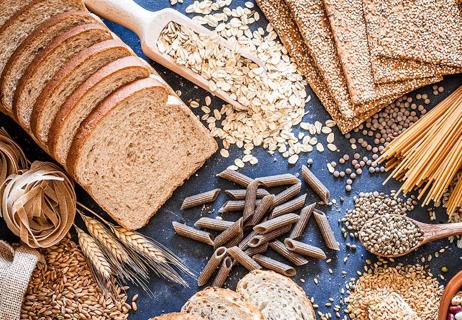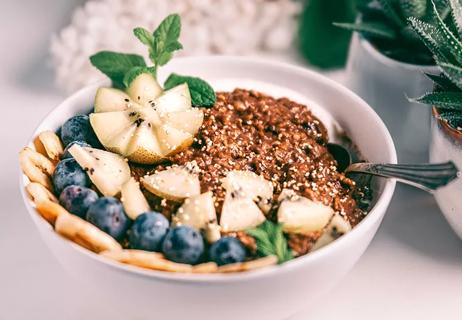Sourdough can be healthier than some other bread choices — but that doesn’t give it ‘health food’ status

Sourdough bread is having a moment. Ever since the COVID-19 pandemic had people looking for new hobbies to pass the time, making your own sourdough has become something of an American pastime.
Advertisement
Cleveland Clinic is a non-profit academic medical center. Advertising on our site helps support our mission. We do not endorse non-Cleveland Clinic products or services. Policy
The apple pie of the 2020s.
And while some people have turned into overnight bakers to break out of the tedium of quarantine life, others are hyping their homemade dough as something akin to a superfood.
But is sourdough really healthy for you?
It’s a matter of perspective, says registered dietitian Beth Czerwony, RD, LD. She breaks down the truth about sourdough bread and what you’re really getting.
To understand the potential health benefits of sourdough bread, let’s start with what makes sourdough bread different from your traditional loaf.
Most bread relies on adding yeast, and you can add yeast to a sourdough recipe to make it move along faster if you choose to.
But traditional homemade sourdough bread takes time. Days even. And it uses wild yeast from the air around you. That’s right, there are microscopic wild yeast particles in the air around us.
Wild yeast, allowed to cultivate over the course of a week or so, is what helps sourdough bread to rise and ferment. That sets sourdough apart from other yeasted breads in taste, look and nutrition.
Sourdough can be made with the most minimal of ingredients. Namely water and flour.
You begin by making a sourdough starter. Here’s how:
Advertisement
Once your starter is ready, you can use it to make your bread by combining the starter with more flour, water and a bit of salt.
Mix. Knead. Shape. Proof. Bake. Bada-boom-bada-bing, bread time!
But does all that waiting, watching, feeding and kneading make your sourdough healthy?
It’s a matter of what you mean by “healthy,” Czerwony notes. Sure, sourdough bread has some health benefits over your traditional white bread in a bag. But healthy-healthy? Like in the way that apples or broccoli are healthy? Ehhhh.
“The thought process is that fermentation is what makes sourdough ‘healthier’ for some people,” she adds. “But there are a lot of ways to define healthy. It depends on what you’re trying to achieve.”
Consider these potential benefits of sourdough bread.
Living in our intestines are trillions of microbes that help keep your belly (and the rest of you) healthy. Their well-being is essential to your gut health, which is important for digestion, immunity, mental health and more.
One way to keep your gut microbiome healthy? Eating fermented foods. Like sourdough bread.
“Sourdough bread ferments over time. That’s what causes those bubbles to form and creates holes in the bread when you cut into it,” Czerwony explains. “Fermentation creates prebiotics, which are what feed the healthy bacteria in your gut.”
But sourdough isn’t the only way to get those prebiotics. Other sources of prebiotics on your plate include foods like:
If you’re watching your sugar intake, people will tell you that bread is something to steer clear of. But thanks to the fermentation process, sourdough has a lower glycemic index than some other breads.
In other words, it may not spike your blood sugar as quickly, which is particularly important to people with diabetes.
“Fermentation eats up some of the natural sugars found in the grains. That causes chemical changes that affect the structure of the carb itself. Those changes make it such that the body only absorbs parts of those carbs, which lowers its effects on your blood sugar,” Czerwony further explains.
For comparison, a typical slice of white bread has a glycemic index of 100. Foods with a number higher than 70 are considered to be high glycemic index foods.
Sourdough bread has a glycemic index of around 55. Typically, low glycemic index foods are those with a number of 50 or less.
Sourdough, then, falls somewhere in between. Near the low side, but not low enough to be considered “low.” So, if blood sugar control is the goal, sourdough may be a moderately healthy choice for you.
Advertisement
“I wouldn’t tell somebody who has diabetes or somebody who wants to lose weight that they need to change over to eating only sourdough bread or encourage them to eat it all the time,” Czerwony notes. “But it can fit into an overall healthy diet, if it’s something you like and are interested in.”
Other breads and bread substitutes can come with even lower glycemic indexes. They include:
It’s worth noting that these numbers are estimates. Glycemic indexes can vary greatly between brands and recipes.
People who are sensitive to gluten may be able to better digest sourdough bread. That’s because the fermentation process helps decrease the amount of gluten in sourdough bread.
But sourdough isn’t gluten-free. So, people with celiac disease who have to avoid all gluten are likely to be advised against it.
But for people for whom large amounts of gluten cause digestive woes, sourdough bread may be an alternative to going full-on gluten-free.
A typical sourdough can miss a key nutrient that makes some other foods even healthier choices.
Namely, fiber.
A lot of sourdoughs use all-purpose flour in their recipes — the same flour used in your average white bread (not to mention cakes, cookies and other baked goods).
Advertisement
During manufacturing, all-purpose flour and other white refined flours lose much of their fiber content.
Breads that contain higher amounts of fiber can be a better choice for a lot of people. Fiber helps you stay fuller longer. And it can keep your body from fully absorbing carbohydrates. That means lower effects on your blood sugar.
But you can get the benefit of fiber in your sourdough.
Choose recipes and bakery items that use whole-wheat flour, spelt flour or rye flour instead of all-purpose flour. Those flours retain more fiber content when milled.
All in all, sourdough can be a healthier choice than some other breads. But that doesn’t mean it’s a good idea to scarf down a loaf a day.
“Sourdough can be part of an overall healthy diet. But if you’re looking to make healthier food choices, it wouldn’t be my first go-to,” Czerwony clarifies.
“It comes down to making choices. If you enjoy making sourdough and having a slice of it here and there, there’s nothing wrong with that. But there are always going to be other foods that are going to do even more for your body and your goals.”
Advertisement
Learn more about our editorial process.
Advertisement

A whole grain, sorghum is chock-full of antioxidants and nutrients that boost energy, support a healthy immune system and more

Options like almond, oat and coconut flours offer a decent amount of protein and fiber

Eating this grain could help keep tabs on your appetite and protect against diabetes and cancer

Made from sprouted whole grains and legumes, it’s low calorie and full of fiber and protein

A diet rich in whole grains improves gut health, protects your heart and may reduce cancer risk

Move over oatmeal! It’s time to make room at the table for these grain options

No longer forbidden, this rice is more nutritious than other types

The answer is clear, but there are factors to consider

Start having sex about 72 hours before ovulation, then at least every other day during your fertile window

Attachment theory suggests that your earliest relationships shape connections throughout your life

It isn’t a recognized mental health disorder, but research shows that problematic social media use can negatively affect your mental health, self-esteem and sleep